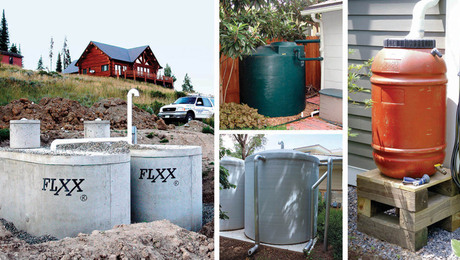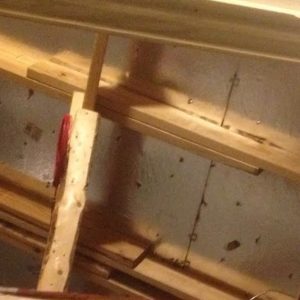I just purchased a brand new home in the D/FW area and noticed roof has no connector plates. Rafters are all nailed together. Is this normal? I see no connector plates like my previous home.
Discussion Forum
Discussion Forum
Up Next
Video Shorts
Featured Story

There's a constant source of clean water for you to use, and all you have to do is collect it.
Featured Video
How to Install Exterior Window TrimHighlights
"I have learned so much thanks to the searchable articles on the FHB website. I can confidently say that I expect to be a life-long subscriber." - M.K.


















Replies
Looks very suspicious. I'd like to see a picture that shows more of the framing.
Mike
Suspicious is an interesting word for it.
A full on picture with lengths of framing would be very beneficial. There appear splices and some sort of hold up under them.
ARE CONNECTOR PLATES REQUIRED?
Thanks for the response..
I have included a few other photos.. Hope this helped.
Thanks!!
rn
What's the detail in those pics that appear to show 2-2x4's on edge, stacked on top of one another? Perhaps my eyes are deceiving me?
was this home built with a permit and if so, have you asked your inspection dept?
thanks.
CONNECTOR PLATES
Home is brand new.. built by one of the major home builders... Which picture are you referring to so I can focus more on it.
Thanks
That certainly would not be allowed in Florida but you are in Texas. Who knows.
reflection?
I saw the same thing. I think it might actually be the reflection of the lumber in the foilfaced insulation. A mirror-type of effect.
dddddddddddddddddddddddddddddddddddddd
uh.
Boy, either bigger screen, eye exam or dig the hole-I'm ready to fall in.
What's up with the splices though.............or was that a reflection too?
I'm done with this, too dumb to know. I think I'll take up forum developer............ing.
ah ha!
Well then, this may very well be an opportune time for me to come out and challenge you to a game of horse shoes!
Horse shoes
Whatever you do, if Joyce gets involved? Do NOT agree to play for money!
atta boy jimbo
They worry about joyce and I unleash the magic.
They'll never know what hit'em
splices
Overlaps are fine in rafters when stick framing, you just need proper length of overlap (it appears they have plenty) and a proper nailing schedule at the overlap (which I can't tell). But as Andy wrote earlier, the overlap, unless it's designed as a structural union, usually needs to be supported. I usually add a load-bearing knee wall under the splice, with the load properly transferred down to the attic floor joists and onward down through the structure.
I'm required to have hurricane ties where the bottom end of the rafter birdsmouth bears on the top plate. And I don't know if this is code or just a local thing or just an inspector thing, but my inspector also wants hurricane clips where the spliced rafters overlap the knee wall.
These aren't trusses
Perhaps part of the confusion is that this is a stick framed roof, and you're used to seeing trusses? There would not normally be connector plates in a stick framed roof. There might be some hurrican ties where the rafters meet the wall plate, but that would be it. In one spot, it looks like there's a splice in the rafters that's supported by a stud wall and a single ply header. Assuming the stud wall is part of a legitimate load path, looks okay to me. But it's really hard to say without seeing the attic as a whole.
Overall? Sloppy
The rafters look like 2x6, 16" oc, with foil-faced RFBI on top, and the roof sheathing on top of the RFBI?
Like Andy wrote, there's really nothing wrong with overlapping the rafters, but the splice will usually need structural support from underneath. As long as that overlap is well nailed, connectors are not required at that overlap splice.
Your rafter splice does have support, but it's very sloppy and suspect in nature. Can't tell from the photo, but in your "trusses_3" photo it looks like the rafter splice horizontal support is a single 2x4 or may be a 2x6 on edge, with the bottom edge of the rafters simply touching a corner/edge of the horizontal 2x6 support?
The horizontal 2x6 itself is let into a vertical 2x4 that runs from the attic floor framing to the rafters, and that vertical 2x4 has another vertical 2x4 flat nailed to it to act as a strongback.
In my book, the bearing and connection of the rafters to that horizontal 2-by is inadequate if it's simply toenailed off. Not to mention we can't see how those verticals are carried down to the attic floor joists, or if the joists are sized to carry that roof load. If the vertical-to-joist connection in photo #5 is any indication? Not promising.
It is hard for me to pick out what bears on what. I will say that a few of the heel cuts that are visible look sloppy, and some of the bracing, or what looks like bracing, is just a 2x4 wedged into place and nailed off. The valley rafter cuts do look neat and accurate.
The framing in "trusses_2", I don't know what your load requirements are for where you're building. But off the top of my head I'm thinking that 2x6 rafters 16" oc are allowed about a 12' span. Again, that depends on YOUR live/dead/snow load requirements. Can't see how hight the cathedral goes in that photo, but if a 12' span is indeed your limit, you might be close to it.
It could be structurally sound. Or it might be lacking a bit. But to me it is sloppy work. It's not what you want to see in a stick-framed roof.
It looks to me as if these splices are supported by a purlin that is in turn supported by 2 2x4s nailed together in a T or L shape at every other rafter. If this assumption is correct I don't think you have much to worry about. Especially if this constrution was inspected and done by a reputable builder.
Kind of depends on what supports those "T's" too, doesn't it Mike? Where that load is transferred to?
same
Agree.
The idea of the purlin is correct.
The idea of the purlin being supported by the "T"'s is correct.
But two things, and they are things not clearly shown in the photos: How are the "T's" that support the purlin tied into the attic floor framing. If it's anything like what is shown in photo #5, it's questionable. The second is how the rafters bear on the purlin. It's not supposed to be corner to corner. There should be a flat surface bearing on a flat surface.
What he shows in the photos doesn't make me happy, but I like clean framing. This will probably sound odd, but neat framing is just gorgeous to me. It doesn't have to be fine-furniture like in quality, but it should give you comfort instead of raising questions. What he has may indeed be structurally sound. But if the work is sloppy enough to where most of us are questioning it? Then it's just sloppy work.
I guess they assume the wind never blows there. "Up" is a load too.
The valley rafters look light to me. But I'm notorius for over framing stuff and it's hard to see exactly what's what from those photos.
I don't like the looks of it. To me, it looks like typical half-a$$ed stick framing I see. Whatever looks good is thrown up, with no thought to how it all works as a system.
If the house is new, the framer should be able to back it up with engineering. Or the bulding department should be able to inspect it.